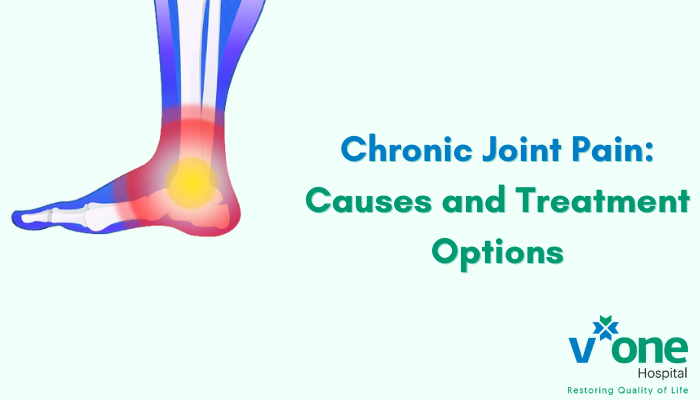Dealing with Chronic Joint Pain: Causes and Treatment Options
Are you or someone you know grappling with chronic joint pain that just won’t let up? If so, you’re not alone. Chronic joint pain affects millions worldwide, impacting daily activities and overall quality of life. In this comprehensive guide, we’ll delve into the causes behind persistent joint discomfort and explore effective treatment options that can help you regain control and find relief.
Understanding Chronic Joint Pain
Chronic joint pain is more than just an inconvenience; it’s a daily struggle that can affect various joints in the body, from knees and hips to shoulders and wrists. Unlike acute pain resulting from an injury or trauma, chronic joint pain persists for weeks, months, or even years. It’s often linked to underlying medical conditions that require careful attention.
Common Causes of Chronic Joint Pain
1. Osteoarthritis
Osteoarthritis is a leading cause of chronic joint pain, especially in older adults. It occurs when the protective cartilage that cushions the ends of your bones wears down over time, leading to pain, swelling, and stiffness.
2. Rheumatoid Arthritis
Unlike osteoarthritis, rheumatoid arthritis is an autoimmune disorder where the immune system mistakenly attacks the joints, causing inflammation and pain. It can affect multiple joints and may lead to long-term joint damage.
3. Inflammatory Joint Diseases
Conditions such as lupus and psoriatic arthritis fall under this category. These diseases trigger inflammation in the joints, resulting in persistent pain and if left untreated, potential joint damage.
4. Joint Overuse or Misuse
Repetitive motion or improper use of joints, common in certain occupations or activities, can contribute to chronic joint pain over time. This is often seen in athletes, laborers, or those with physically demanding jobs.
Treatment Options for Chronic Joint Pain
Chronic joint pain demands a tailored approach to alleviate discomfort and improve overall joint function. Below, we explore various treatment options in detail, providing insights into their mechanisms and potential benefits:
1. Medications
Pain Relievers
Acetaminophen: Widely used for mild to moderate pain relief, acetaminophen is often recommended for those with joint pain not associated with inflammation. It works by blocking pain signals in the brain but does not have anti-inflammatory properties.
Nonsteroidal Anti-Inflammatory Drugs (NSAIDs): Common NSAIDs like ibuprofen and naproxen sodium are effective in reducing both pain and inflammation. They work by inhibiting enzymes that contribute to inflammation.
Prescription Medications
Corticosteroids: In some cases, a short course of oral corticosteroids may be prescribed to reduce inflammation. Additionally, corticosteroid injections directly into the affected joint can provide targeted relief.
Disease-Modifying Antirheumatic Drugs (DMARDs): Typically used for autoimmune conditions like rheumatoid arthritis, DMARDs aim to slow or stop the immune system from attacking the joints, thereby reducing inflammation and preventing joint damage.
2. Physical Therapy
Physical therapy is a cornerstone of joint pain management, focusing on exercises and techniques to improve joint mobility, strength, and flexibility.
Therapists tailor programs to individual needs, incorporating stretches, strengthening exercises, and low-impact activities to enhance joint function.
Water-based exercises, like swimming or aquatic therapy, are gentle on the joints while providing an effective workout.
3. Lifestyle Changes
Weight Management
Maintaining a healthy weight is crucial, especially for weight-bearing joints like the knees and hips. Excess weight can exacerbate joint pain and contribute to the progression of conditions like osteoarthritis.
A combination of a balanced diet and regular exercise can help achieve and sustain a healthy weight.
Joint-Friendly Exercise
Engaging in activities that are easy on the joints can promote overall joint health. Consider low-impact exercises like biking, elliptical training, or swimming.
Working with a fitness professional or physical therapist can help design an exercise plan that suits individual needs and limitations.
4. Injections
Corticosteroid Injections
These injections deliver powerful anti-inflammatory medication directly into the affected joint, providing swift relief from pain and swelling.
While effective for short-term relief, corticosteroid injections are not a long-term solution and are typically used sparingly due to potential side effects.
Hyaluronic Acid Injections
Particularly employed for knee osteoarthritis, these injections supplement the joint’s natural synovial fluid, providing lubrication and cushioning. This can ease pain and improve joint function.
The effects of hyaluronic acid injections may last several months, and the procedure is generally well-tolerated.
5. Surgery
Joint Replacement
For severe cases where conservative treatments are insufficient, joint replacement surgery may be considered.
Commonly performed on knees and hips, joint replacement involves removing damaged joint surfaces and replacing them with artificial implants, effectively reducing pain and restoring mobility.
Arthroscopy
This minimally invasive procedure involves inserting a small camera into the joint to assess and treat issues such as cartilage damage or loose fragments.
While not a cure for chronic joint pain, arthroscopy can address specific problems and improve joint function.
Coping Strategies for Daily Living
In addition to medical interventions, adopting coping strategies for daily living can significantly enhance the management of chronic joint pain:
Mind-Body Techniques
Practices like yoga and meditation can promote relaxation, reduce stress, and contribute to better pain management.
Assistive Devices
Canes, braces, and ergonomic tools can assist with daily activities, reducing strain on the joints.
Heat and Cold Therapy
Applying heat or cold to affected joints can alleviate pain and inflammation. Experiment with both to determine which works best for you.
Support System
Building a support network can provide emotional encouragement and practical assistance in managing chronic joint pain.
When to Seek Professional Help?
Persistent joint pain should not be ignored. If you experience any of the following, it’s crucial to seek prompt medical attention:
- Sudden and severe joint pain.
- Joint swelling, redness, or warmth.
- Difficulty using or moving the joint.
- Symptoms that persist despite home remedies.
In Conclusion
Dealing with chronic joint pain requires a multifaceted approach. By understanding the causes and exploring various treatment options, you can take proactive steps toward managing your pain and improving your overall quality of life. Remember, you don’t have to face chronic joint pain alone -consult with a healthcare professional to develop a personalized plan that works for you. There’s hope for a more pain-free and active future.

